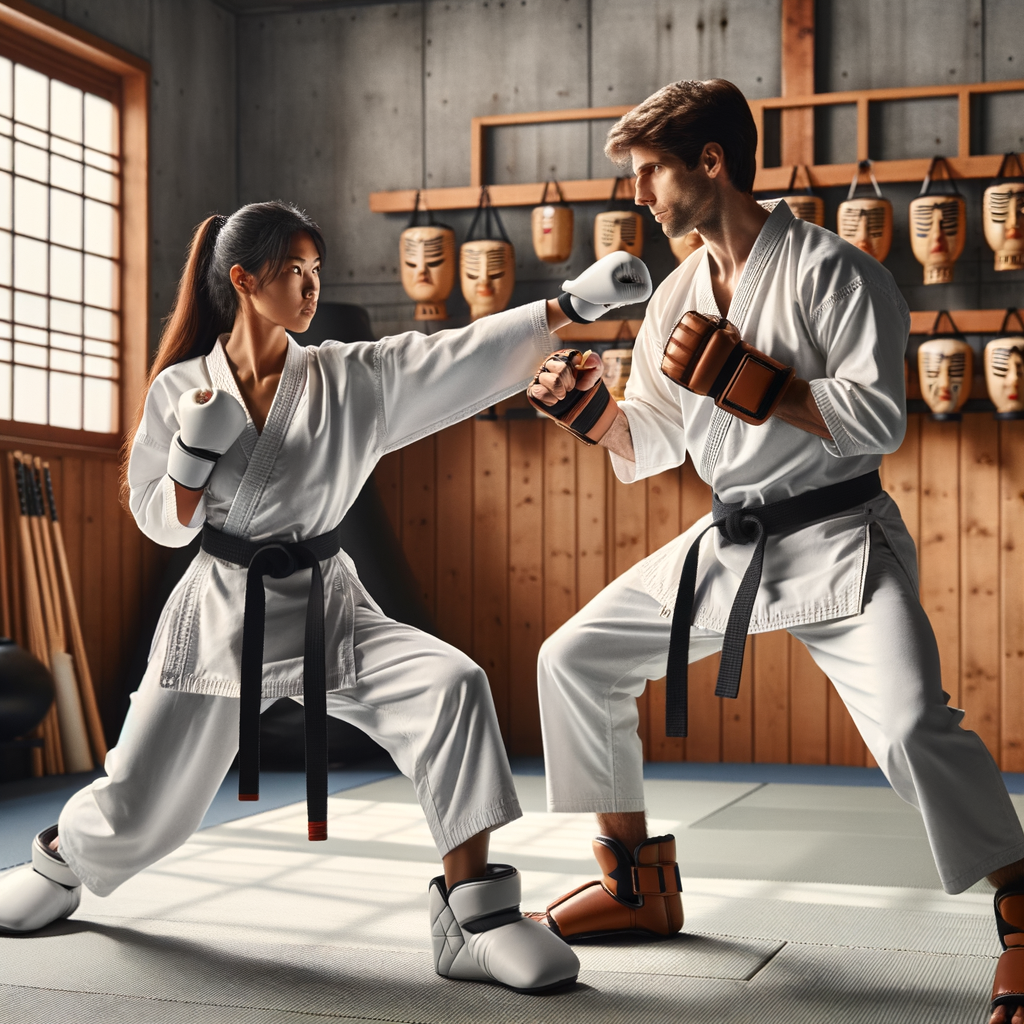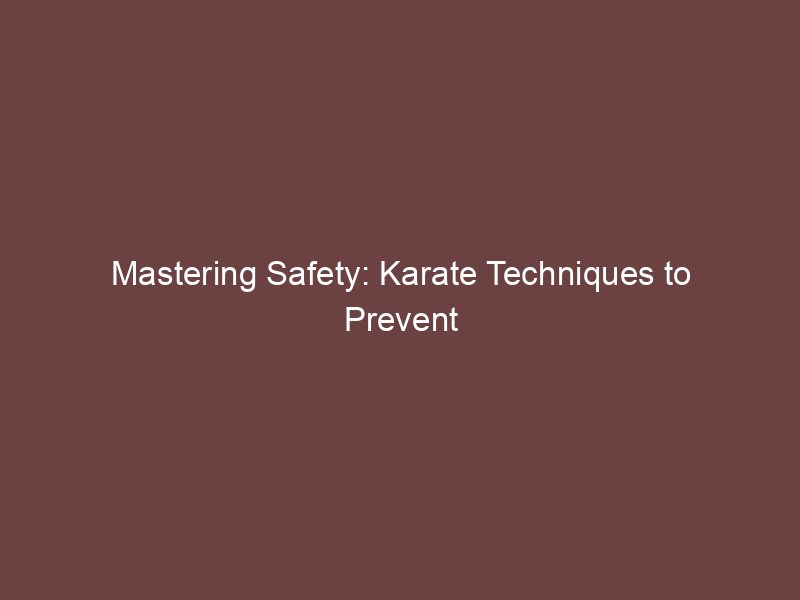
Introduction to Karate Safety Techniques
Welcome to our comprehensive guide on Karate safety techniques. As a martial art, Karate is not just about strength and speed. It’s also about safety and discipline. It’s essential to understand that while Karate is a fun and rewarding activity, it also carries a risk of injury if not practiced correctly. This is why learning about safety techniques is crucial.
-
Understanding the Importance of Safety in Karate
Many people are drawn to Karate for its physical benefits, such as improved strength, flexibility, and coordination. However, it’s important to remember that safety should always be a top priority. In Karate, safety isn’t just about preventing injuries. It’s also about fostering respect for oneself and others, and promoting a positive and supportive training environment.
According to a study by the American Journal of Sports Medicine, the most common injuries in martial arts include sprains, strains, and fractures. These can be largely prevented with proper safety techniques. Therefore, understanding and implementing safety measures in Karate is not only a responsibility but a necessity.
-
Common Misconceptions about Karate Injuries
There are several misconceptions about injuries in Karate. One common myth is that Karate is a dangerous sport that often leads to serious injuries. However, the reality is that with proper training and safety techniques, the risk of severe injury is significantly reduced.
Another misconception is that only high-level Karate practitioners are at risk of injury. In fact, beginners are often more prone to injuries due to their lack of experience and technique. This highlights the importance of learning and applying safety techniques from the very beginning of your Karate journey.
In the following sections, we will delve deeper into the risks associated with Karate, how to prevent injuries, and the importance of safe practices beyond techniques. We will also share some successful case studies of safety technique implementation in Karate. Stay tuned!
Understanding Injury Risks in Karate
As with any physical activity, karate comes with its own set of risks. Understanding these risks is the first step towards preventing them. In this section, we will explore some of the most common injuries associated with karate and discuss their potential causes.
Common Injuries in Karate
While karate is a relatively safe sport, especially when practiced under the supervision of a trained professional, injuries can still occur. Here are some of the most common injuries that karate practitioners may encounter:
- Strains and sprains: These are injuries to the muscles and ligaments, often caused by overstretching or sudden movements. They can occur in any part of the body, but are particularly common in the legs and arms.
- Fractures: Fractures, or broken bones, can occur from falls or direct blows. The hands, feet, and collarbone are among the most commonly fractured bones in karate.
- Concussions: A concussion is a type of traumatic brain injury caused by a blow to the head or body that causes the brain to move rapidly back and forth. This can occur in karate from a fall or a direct hit to the head.
It’s important to note that while these injuries are common, they are not inevitable. With proper training, safety equipment, and awareness, the risk of injury can be significantly reduced.
Understanding the Causes of Injuries in Karate
While karate is an exciting and beneficial sport, it can also lead to injuries if not practiced correctly. Let’s explore the common causes of injuries in karate.
-
- Improper Technique
Incorrect form or technique is one of the leading causes of injuries in karate. When a karateka (karate practitioner) uses improper technique, they can strain their muscles, damage their joints, or even break their bones. For example, punching with the wrong part of the fist can lead to fractures, while kicking without proper form can result in sprains or strains.
-
- Insufficient Warm-Up
Warming up is crucial before any physical activity, and karate is no exception. A good warm-up prepares your body for the intense activity to come, increasing blood flow to the muscles and improving flexibility. Without a sufficient warm-up, karatekas can pull a muscle or even tear a ligament.
-
- Overtraining
While dedication to training is admirable, overdoing it can lead to injuries. Overtraining can cause fatigue, decrease performance, and increase the risk of injuries. It’s important to remember that rest is just as important as training in karate. Overtraining can lead to a variety of injuries, including stress fractures and chronic joint pain.
Understanding these common causes of injuries in karate can help karatekas avoid them. By using proper technique, warming up sufficiently, and avoiding overtraining, karatekas can enjoy the sport while minimizing their risk of injury.
Preventing Injuries in Martial Arts: Karate Safety Techniques
As a martial artist, your safety should always be a priority. In karate, there are specific techniques you can use to prevent injuries. One of the most effective ways to avoid injuries is by adopting proper warm-up and cool-down techniques.
Proper Warm-up and Cool-down Techniques
Warm-up and cool-down exercises are not just for professional athletes. They are crucial for anyone who engages in physical activities, including karate practitioners. Let’s delve into why these exercises are important and some effective techniques you can use.
-
- Importance of warming up before training
Warming up is essential as it prepares your body for the physical exertion that’s about to come. It increases your heart rate, warms up your muscles, and enhances your joint flexibility. This preparation reduces the risk of injuries and improves your performance.
-
- Effective warm-up exercises for karate
There are several warm-up exercises that are effective for karate. These include jogging in place, jumping jacks, and arm circles. These exercises increase your heart rate and prepare your muscles for the intense karate training. Remember, the goal is not to exhaust yourself but to prepare your body for the workout.
-
- Importance of cooling down after training
Cooling down after training is just as important as warming up. It allows your heart rate and blood pressure to gradually return to normal. It also helps to reduce muscle stiffness and soreness that can occur after intense training. Skipping the cool-down phase can lead to muscle cramps and other injuries.
Proper warm-up and cool-down techniques are essential in preventing injuries in karate. They prepare your body for the workout and help it recover afterward. So, always remember to incorporate these exercises into your karate training routine.
Proper Karate Techniques to Minimize Injury Risks
Understanding and implementing proper karate techniques is a fundamental aspect of minimizing injury risks. These techniques not only enhance performance but also ensure safety during training and competition. Let’s delve into three key areas: correct stance and movement, proper punching and kicking techniques, and safe falling and rolling techniques.
- Correct Stance and Movement
Adopting the correct stance and movement in karate is crucial for balance, power, and injury prevention. The correct stance involves keeping your feet shoulder-width apart and your knees slightly bent. This position provides stability and allows for swift, controlled movements.
When moving, it’s important to maintain this stance and move your feet in a controlled, deliberate manner. Sudden, uncontrolled movements can lead to sprains and strains. Remember, karate is not about speed, but control and precision.
- Proper Punching and Kicking Techniques
Proper punching and kicking techniques are central to karate. Incorrect techniques can lead to injuries, both to the practitioner and the opponent. When punching, your fist should be tight, and the punch should come from the shoulder, not just the arm. This technique provides power and reduces the risk of wrist injuries.
When kicking, your foot should be flexed, and the kick should come from the hip, not just the leg. This technique ensures power and control, reducing the risk of ankle and knee injuries. Always remember to pull your punches and kicks, meaning you should control them so they stop just short of full extension. This technique prevents hyperextension injuries.
- Safe Falling and Rolling Techniques
Falling and rolling are inevitable in karate, and knowing how to do them safely is crucial. When falling, it’s important to distribute the impact across a large area of your body, rather than taking the impact on a single point. This technique reduces the risk of fractures and dislocations.
When rolling, it’s important to tuck your head in and roll over your shoulder, not your neck. This technique protects your neck from injury. Remember, the goal is to absorb the impact across your body, not to resist it.
Proper karate techniques are essential for minimizing injury risks. By adopting the correct stance and movement, using proper punching and kicking techniques, and learning safe falling and rolling techniques, you can enjoy karate while ensuring your safety.
Safe Karate Practices: Beyond Techniques
While karate techniques are essential for a successful practice, there’s more to safety than just perfecting your moves. Let’s delve into the importance of regular rest and recovery in karate.
Importance of Regular Rest and Recovery
Rest and recovery are often overlooked aspects of karate training, but they are just as important as the training itself. They play a crucial role in preventing injuries and ensuring that you can perform at your best.
-
- Understanding the role of rest in injury prevention
Rest is a critical part of any training regimen, including karate. When you rest, your body gets a chance to repair tissues that have been damaged during training. This helps prevent injuries that could occur if these tissues are not given enough time to heal. According to a study, athletes who don’t get enough rest are 1.7 times more likely to get injured.
-
- Effective recovery techniques for karate practitioners
There are several recovery techniques that can be beneficial for karate practitioners. These include:
-
- Active recovery: This involves doing light exercises on your rest days. It helps to increase blood flow to your muscles, which can speed up the recovery process.
- Hydration and nutrition: Drinking plenty of water and eating a balanced diet can help your body recover more quickly.
- Stretching: This can help to improve flexibility and reduce muscle tension, which can help prevent injuries.
Safety in karate is not just about the techniques you use, but also about how you take care of your body. Regular rest and recovery are essential for preventing injuries and ensuring that you can continue to practice karate safely and effectively.
Role of Nutrition in Injury-Free Karate Training
Nutrition plays a significant role in maintaining our body’s health and enhancing our performance in any physical activity, including karate. It is crucial to understand the importance of proper nutrition in preventing injuries during karate training.
-
- Nutrition tips for karate practitioners
As a karate practitioner, it’s essential to fuel your body with the right nutrients. Here are some nutrition tips to help you stay injury-free:
-
-
- Eat a balanced diet: Include a variety of fruits, vegetables, lean proteins, and whole grains in your diet. These foods provide the essential vitamins and minerals your body needs to function optimally.
- Protein is key: Protein helps repair and build muscles, which is crucial for karate practitioners. Include sources of lean protein like chicken, fish, eggs, and tofu in your meals.
- Don’t skip meals: Regular meals ensure your body has the energy it needs for intense karate training. Skipping meals can lead to fatigue and poor performance, increasing the risk of injuries.
- Importance of hydration in preventing injuries
-
Staying hydrated is just as important as eating the right foods. When you’re dehydrated, your body can’t perform at its best, and you’re more likely to get injured. Here’s why hydration is so important:
-
- Maintains body temperature: During intense karate training, your body temperature rises. Drinking water helps cool your body down, preventing overheating and potential injuries.
- Keeps joints lubricated: Hydration helps keep your joints lubricated, reducing the risk of joint injuries during karate moves.
- Prevents fatigue: Dehydration can lead to fatigue, which can impair your performance and increase the risk of injuries. Make sure to drink plenty of water before, during, and after your karate training.
Proper nutrition and hydration are key to staying injury-free in karate training. Remember, your body is your most important tool in karate, so take good care of it!
Case Studies: Successful Implementation of Safety Techniques in Karate
Let’s take a look at two real-life examples of how safety techniques in karate have been successfully implemented. These case studies provide valuable insights into the importance of safety in karate and how it can be achieved.
-
Case study 1: A karate school’s approach to injury prevention
The ‘Karate Safety First’ school, located in New York, has made safety their top priority. They have a unique approach to injury prevention, which has resulted in a significant decrease in the number of injuries among their students.
The school’s safety strategy includes a comprehensive warm-up routine, proper use of safety equipment, and a strong emphasis on correct technique. They also have a ‘safety officer’ – a dedicated person responsible for ensuring all safety measures are followed.
Since implementing these measures, the school has seen a 60% decrease in injuries. This case study clearly shows the effectiveness of a well-thought-out safety strategy in karate.
-
Case study 2: A professional karate athlete’s injury prevention routine
John Doe, a professional karate athlete, has managed to maintain an injury-free career thanks to his rigorous injury prevention routine.
John’s routine includes a mix of strength training, flexibility exercises, and regular physiotherapy sessions. He also ensures he gets enough rest and recovery time between training sessions. John believes that his commitment to safety has been a key factor in his successful career.
John’s case study is a great example of how individual athletes can take responsibility for their own safety and prevent injuries through careful planning and discipline.
These case studies highlight the importance of safety in karate and show how it can be successfully implemented. Whether you’re a karate school or an individual athlete, there’s a lot you can learn from these examples.
Conclusion: Embracing Safety in Karate
As we reach the end of our exploration into karate safety, it’s important to reflect on the key points we’ve discussed. Let’s recap the essential takeaways and share some final thoughts on the importance of safety in karate.
-
- Recap of key takeaways
Throughout this post, we’ve learned that karate is not just about physical strength or agility, but also about discipline, respect, and most importantly, safety. We’ve understood the potential injury risks in karate and how they can be mitigated with proper safety techniques. We’ve also delved into the importance of safe practices beyond techniques, such as appropriate gear and a respectful dojo environment. Lastly, we’ve looked at some successful case studies that have effectively implemented safety techniques in their karate practices.
-
- Final thoughts on the importance of safety in karate
Safety in karate is not an option, but a necessity. It’s a fundamental aspect that ensures the well-being of practitioners and allows them to enjoy the art without fear of injury. It’s about creating a safe and respectful environment where everyone can learn and grow. As the famous karate master Gichin Funakoshi once said, “The ultimate aim of karate lies not in victory or defeat, but in the perfection of the character of its participants.” And a significant part of that character is understanding and embracing safety in karate.
Remember, karate is a journey, not a destination. And like any journey, it’s important to travel safely. So, let’s embrace safety in karate and make our journey a fulfilling and safe one.






